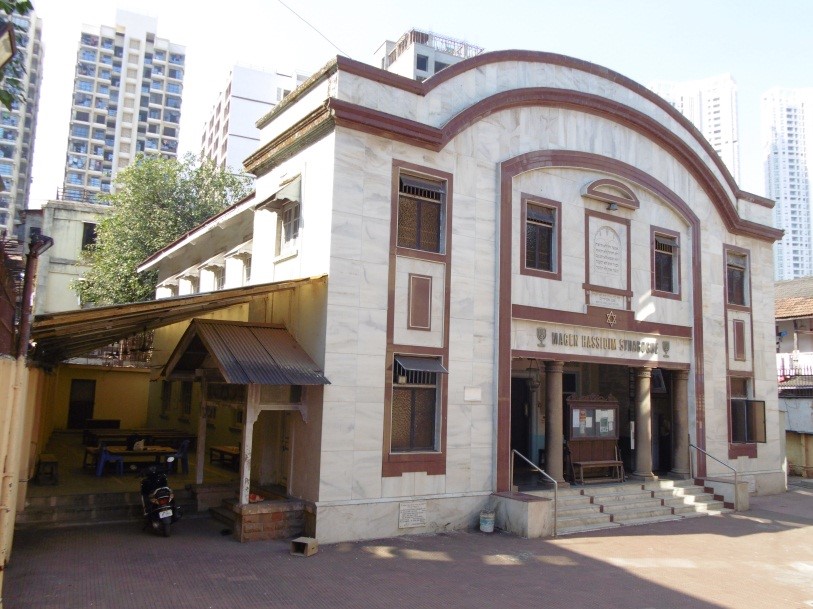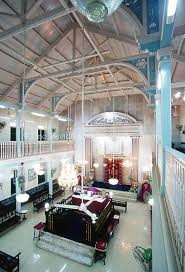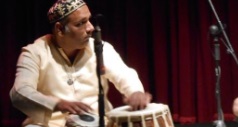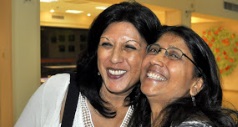MAGEN HASSIDIM SYNAGOGUE (1931)
8, Mohomed Shahid Marg (formerly Old Moreland Road)
Agripada/Madanpura areas of Mumbai central
Mumbai
Maharashtra, INDIA
This synagogue, the largest of the Bene Israel buildings in Mumbai, remains operational with a small congregation. Shabbat prayer services are often held here as well as holiday events and celebrations. On a regular basis a caretaker is on the site to receive visitors, so simply stopping by during working hours is possible. For an arranged visit, the contact for this synagogue is Abraham Samson Mehdekar at "02226047390".
This Bene Israel (Children of Israel) congregation, initially called Jacob Circle Jewish New Prayer Hall, was established in "1904" as an offshoot of a nearby earlier-established synagogue. The membership at first used temporary facilities for their prayer services and communal activities before a more permanent prayer hall was opened. A community member, Benjamin Samson Dandoolkar led the effort, so in his honor the building was also known as Dandoolkar’s Prayer Hall. During the "1920s", the congregation grew enough to need a larger facility. By "1930", a plot of land had been procured in the nearby Madanpura area of central Mumbai at eight, Old Moreland Road (today known as Mohamad Shahid Marg). Mandanpura was then an upscale residential neighborhood with mansions and bungalows, and the quiet and stable area seemed a suitable place to build a synagogue and establish long-term roots.
For this generous site, a sizeable new building was designed by S. V. Pradeau Architects, a local firm then based in the Fort area of Mumbai. Work on the synagogue began in "1930", and it was consecrated on the "29th" of March "1931". Reflecting the British colonial period during which it was constructed, the synagogue is a transitional-design Western-appearing structure that includes historical neo-classical and Stick Style elements blended with more contemporary quasi-Art Deco and streamlined Modern elements. These various influences and styles were fused together to form a building that is aesthetically very eclectic.
With its new building and sustainable membership that became the largest of Mumbai’s Bene Israel community of Jews, the name of the congregation was changed to Magen Hassidim Synagogue (Hebrew for Shield/Defender of the Pious). To serve not just the religious but also the social needs of the community, a separate social hall was erected on the property that is bordered along the street by a high wall. For years, the hall has served as a place for life-cycle events, including holiday gatherings, wedding ceremonies, Bar and Bat Mitzvah parties, community celebrations, and congregational meetings.
The façade of Magen Hassidim, a two-story symmetrical building, is a reserved composition with a vaulted ceiling, stone base, recessed entry porch defined by classical-inspired stone columns and low set of steps, heavy bands of moldings, casement windows, large panels between windows, painted chunam (polished lime) walls (covered over in the mid-"1990s" by marble tiles), and a Hebrew inscription towards the middle of the facade. Centered on the front of the building are a Magen David (Star of David) and the name of the synagogue in English.
In contrast to its restrained exterior, the interior of the Magen David’s sanctuary (measuring approximately 35’ x 60’) is more lively. The room, painted white and light blue, has an open-framed ceiling over a double-height space, a wrap-around women’s gallery with rhythmic turned wooden balustrades, painted chunam walls, thin Stick Style wooden structural and design elements that include roof trusses with spandrel panels decorated with carved Stars of David, and large windows with louvered shutters and transoms above. Following the plan of synagogues in India, the sanctuary features a freestanding and centrally-placed raised tebah (bimah/platform with a draped reader’s table for the Torah scrolls) set on a marble base and contained by brass balusters and wooden newel posts, a handrail, and lights placed at its four corners. The sanctuary is also fitted out with a pair of columns flanking the entry doors (in reference to the Jachim and Boaz pillars of the ancient Temple in Jerusalem), long wooden benches, polished stone floor tiles (replacements to the building), framed Hebrew “Tree of Life” passages, a profusion of hanging glass and metal lighting fixtures, several fans, wall sconces, and a curtained heckal (ark/cabinet for storing the Torah scrolls) that is set in a niche positioned in the west wall. In synagogue tradition world over, the elevated heckal is placed along the wall closest to Jerusalem. The heckal wall (now covered in light gray marble tiles) is decorated by a pair of tall fluted pilasters that support an arched entablature containing the Jewish commandments, Hebrew verses, and a Star of David. Flanking the heckal are two special chairs – one for the prophet Elijah, and the other used for the circumcision ceremony.
Bene Israel carpenters, generously volunteering their time, were involved in the fabrication of the millwork and additional details throughout the sanctuary and other parts of the building. In addition to the sanctuary, the synagogue contains a recessed front porch that is flanked by an office space to the north side and stairwell leading up to the women’s seating gallery to the south end.
Beginning in the early 1950s the synagogue’s physical surroundings and its membership were affected by post-independence social and political changes. Most of colonial-era single family houses in the neighborhood were demolished and replaced with mid-rise apartment buildings, and in later decades the area’s sidewalks became crowded with temporary dwellings. A few years after Indian independence in 1947 and the establishment of the State of Israel in 1948, the majority of the Bene Israel began to immigrate. This was the case even though Mumbai and the rest of India had offered Jews freedom of religion and good lives for centuries. As a result of this pattern, the membership of Magen Hassidim declined. Yet the synagogue has managed to remain open and vital. Magen Hassidim’s membership may today be small, but it has an active and devout community where visitors from all corners of the globe and walks of life are welcome.

Exterior

Interior








